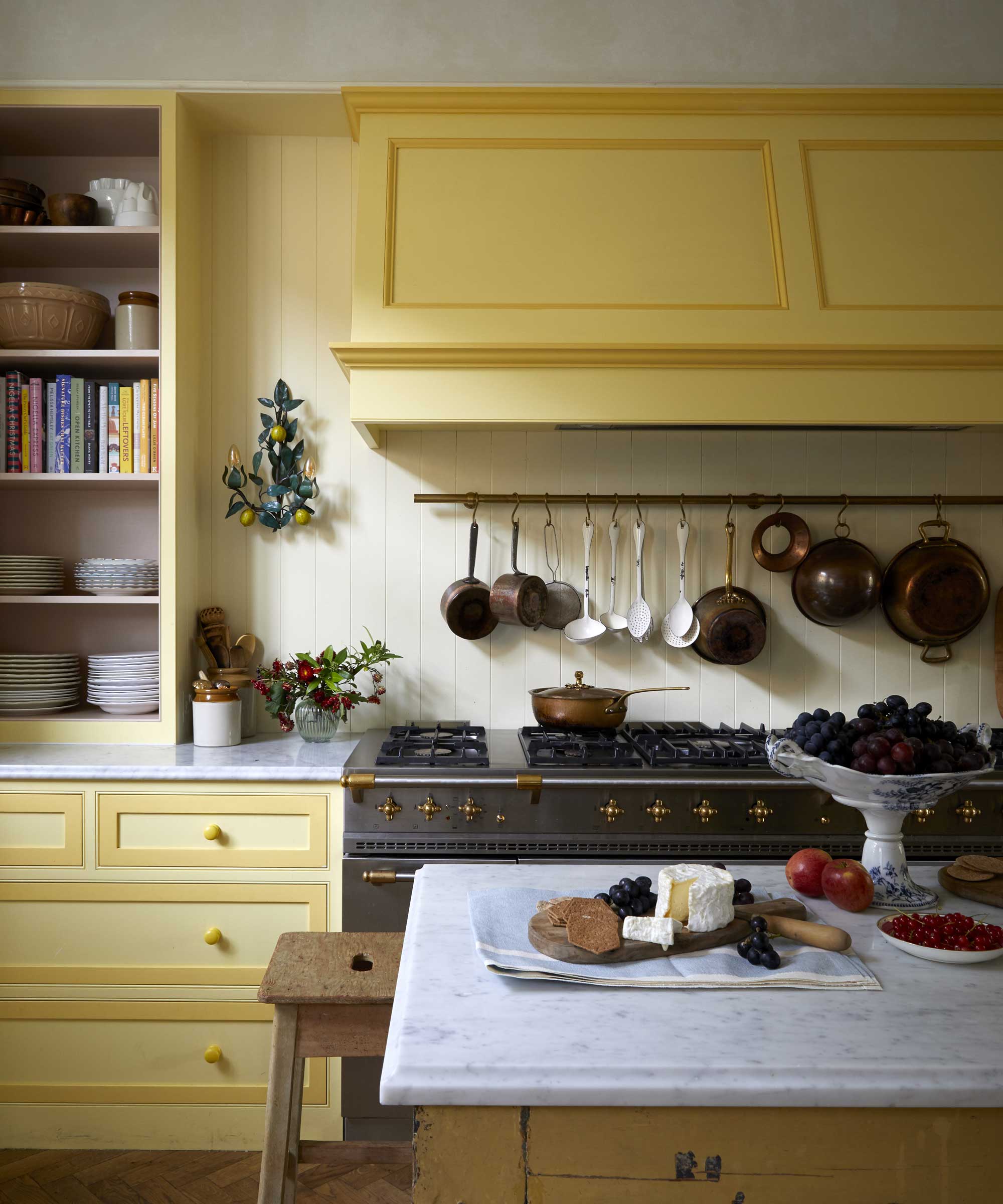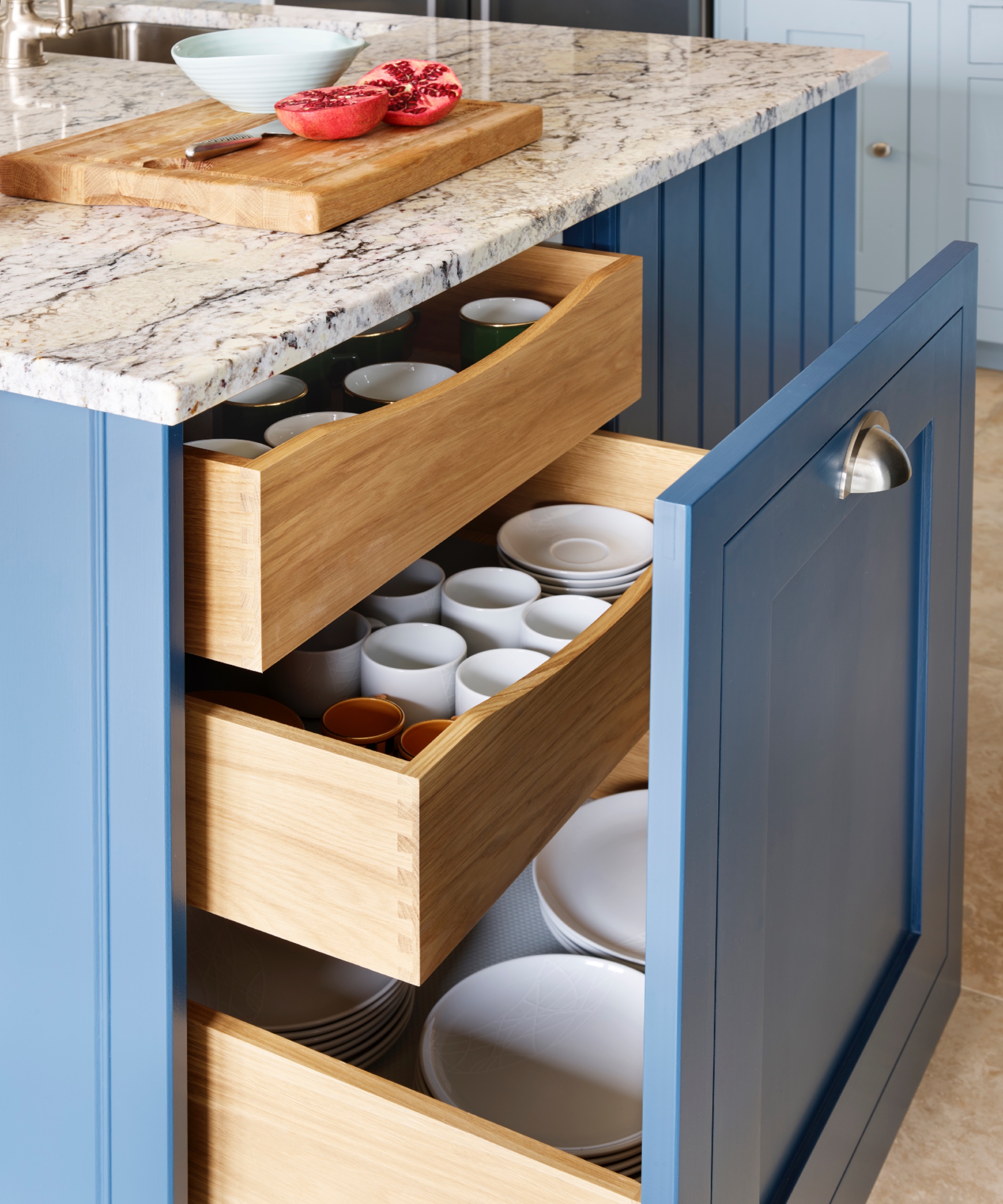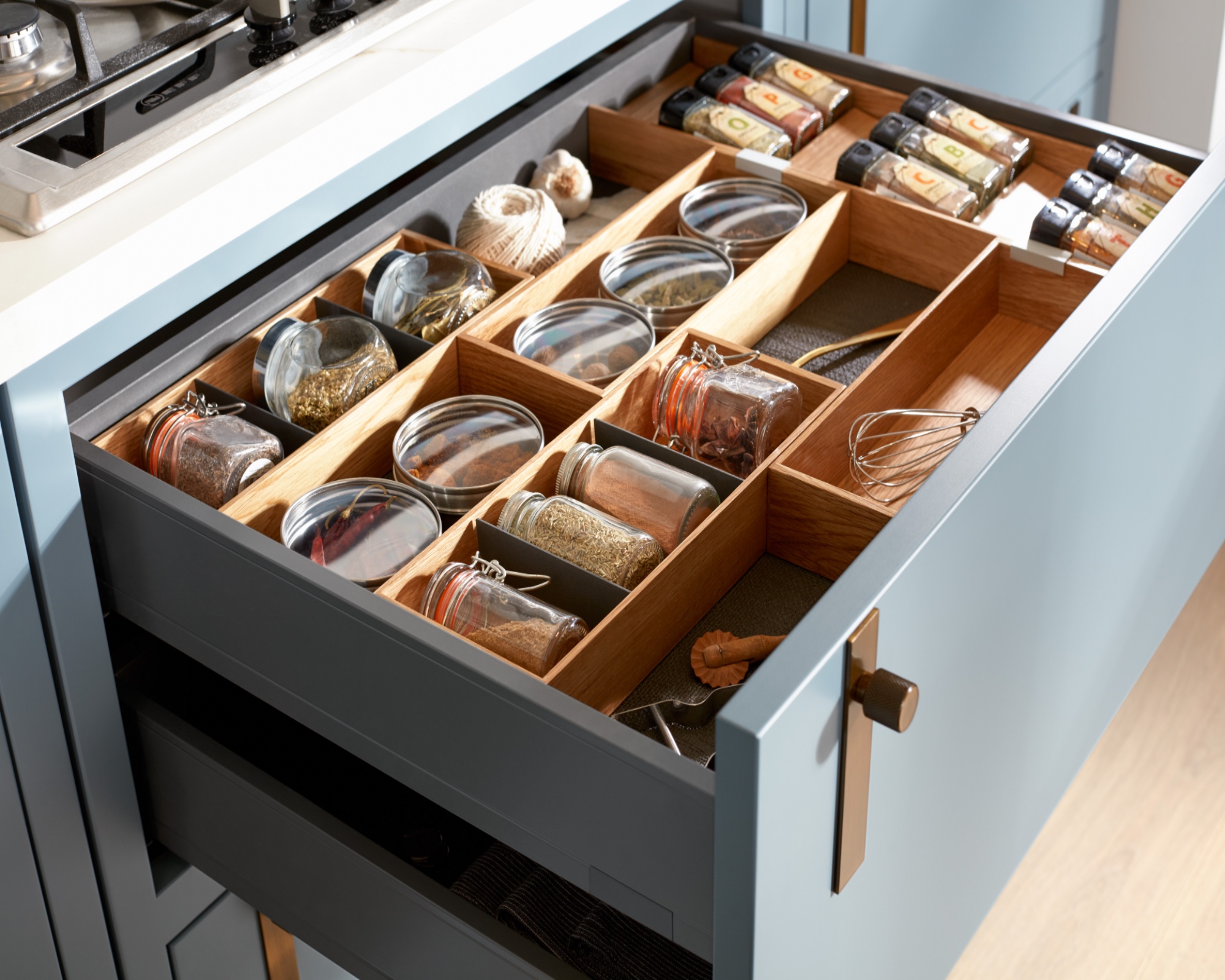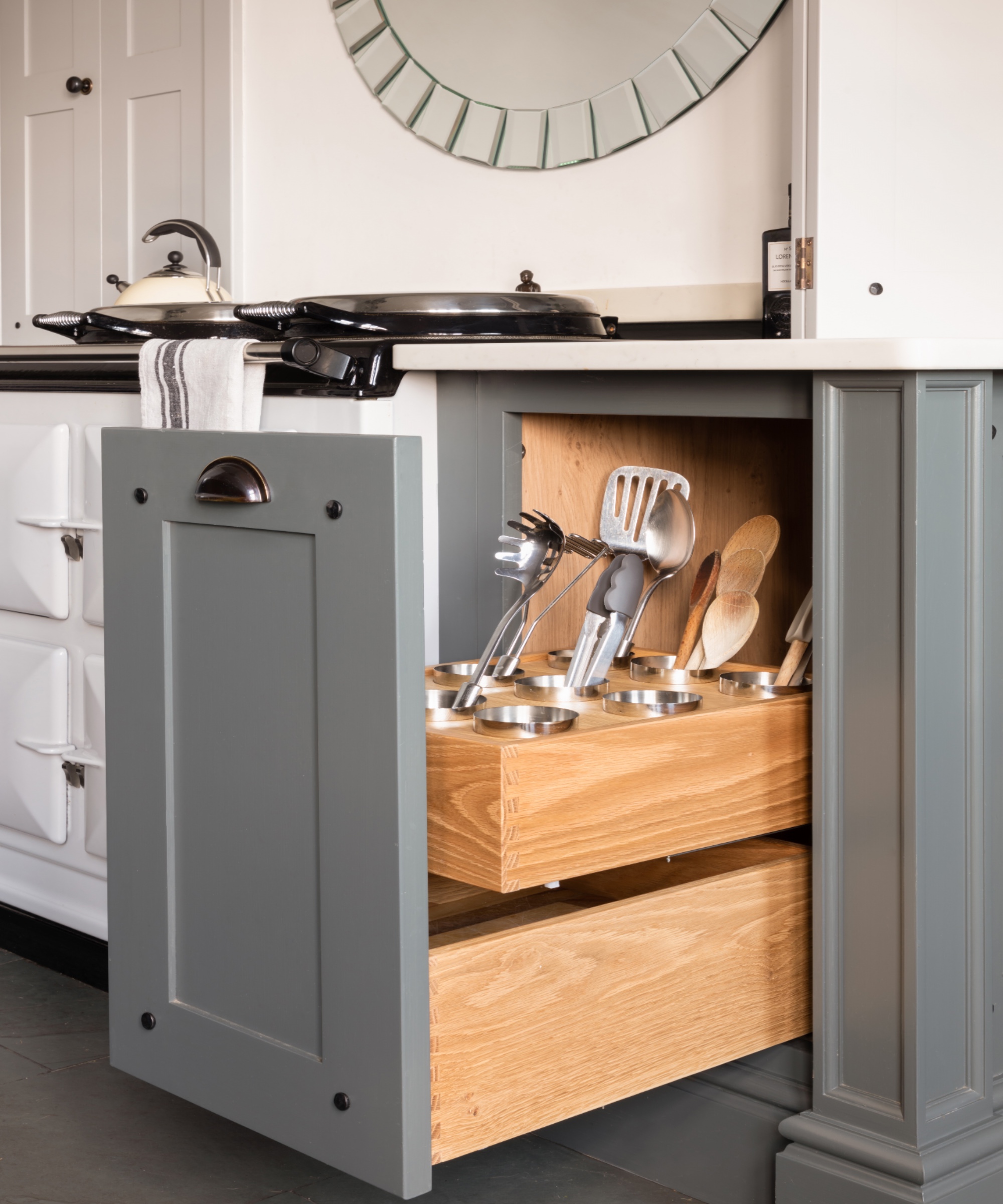
Organizing kitchen drawers has become more critical since the noticeable shift towards using drawers for storage as opposed to the more traditional cabinets in the last few years, with everything from crockery to pots and pans now being housed in them.
Added to this, organizing a kitchen so that it functions seamlessly is vital to our sanity and its aesthetics in a busy home.
‘Kitchen drawers are essential when planning kitchen storage ideas, particularly a small kitchen, as they often offer maximum use of space,’ explains Tom Howley, design director at Tom Howley. ‘They can be tailored to your exact specifications, allowing easy access to kitchen essentials rather than delving into the back of bulging kitchen cupboards.’
With that in mind, a hardworking kitchen drawer organization system – alongside clever storage – is essential to creating a kitchen that’s not just functional, but enjoyable to function in, as well.
Organize kitchen drawers
Alongside our own advice, we’ve gathered top tips from professional organizers, designers and kitchen experts on decluttering and organizing kitchen drawers to ensure your space runs as smoothly as possible. Bear them in mind for any drawers that are part of laundry room organization and utility room organization, too, for a super-efficient home.
1. Give yourself convenient access to regularly used items

‘Try to give each item its own space,’ advises Richard Davonport of Davonport Kitchens. ‘Storage drawers can be designed to be super deep and therefore can hide away a lot of clutter but this doesn’t necessarily make them more user-friendly. If your non-stick frying pan is always hiding underneath five other saucepans of various shapes and sizes, it will be frustrating every time you need to use it. Give important items their own space.’
2. Are you left- or right-handed?

For maximum efficiency, factor access in when planning kitchen cabinet organization, and arrange both cabinets and drawers according to your handedness.
Design expertise in your inbox – from inspiring decorating ideas and beautiful celebrity homes to practical gardening advice and shopping round-ups.
‘I recommend that you put tools for cooking very close to the stove,’ says home organizing expert Katherine Lawrence of Space Matters. ‘This can be in a drawer that is right next to the stove. If you are right-handed, place them in a drawer on the right and if you are left-handed, place them in a drawer to the left.’
It’s worth taking the same approach with everyday cookware: keep pots and pans to the right of the stove if you’re right handed and to the left if you’re left-handed.
3. Think outside the cabinet

Organizing kitchen cabinets might be a chore you're taking on at the same time as organizing the things you should store in drawers in your kitchen, but they do need a different approach.
‘Cupboards may be the traditional go-to storage option, but it’s worth bearing in mind that so many items store better in a drawer,’ says George Forsyth, director at Drew Forsyth & Co.
Professional organizer Lucy Mansey, dubbed ‘the Marie Kondo of Britain’ by her celebrity clients agrees: ‘There is a plethora of practical storage solutions out there for drawers, so giving proper thought to what you’re storing is an important step if you want a well-organized kitchen. Start organizing drawers by taking everything out and laying it on a surface – that way you can see exactly what you’ve got and start to work out which storage systems might work for you.'
4. Clear clutter and clean
Next, consider whether you’ve been making room for things you barely use (holiday and special occasion items aside) and discard them. Non-food items can go to a charity, if someone else could find a use for it, which will give you extra space, handy if you’re working with a small kitchen.
While the drawers are empty, give them a quick clean – it’s not often they’ll be clear, so it’s worth making the most of it.
If you often lose items in dark drawers, consider the colorful drawer organizing trick to make finding what you need simple.
5. Zone drawers to suit your workspace

Think about how you use your kitchen and position drawers accordingly where you can. Pans and utensil drawers stored next to the range or cooker top, glassware drawers in the kitchen island, for example. If you like to entertain, organize drawers with chinaware near to a clear countertop for plating up, and keep cutlery and glassware in drawers away from the main cooking area. That way, servers and chefs can work together in perfect harmony.
‘When you have everything grouped and assigned to drawers, you can then assess what items you use most and prioritize access to them’, says Stephanie Nix, kitchen designer at Neptune.
Juliette Thomas, Founder & Director of Juliettes Interiors agrees; ‘A good rule of thumb is to keep higher drawers for items used most and lower drawers for items not so often used,’ she says. It may sound simple, but this can make a huge difference when it comes to using your kitchen functionally.
6. Dedicate deep drawers to pots and pans...
A wide drawer will likely allow you to organize pots and pans in one readily accessible space, which is much easier than rummaging around at the back of a cabinet – particularly if you’re using them every day.
‘Graduated drawer units like the ones in our Suffolk collection give you the option to neatly store lids in the shallower drawers at the top and deeper pots in the bottom,’ says Stephanie.
Stacking pots and pans can result in scratching, as well as rattling when you open and close the drawer. Installing an internal pan rack to organize kitchen drawers neatly can solve the problem, allowing for easy access and space around each item. Choose from vertical and horizontal designs, or you speak to your kitchen designer about bespoke options.
If you do decide to stack, invest in pan protectors and line the bottom of the drawer to prevent scratches.
7. …and to chinaware

Stack tableware by type for ready access, and bear weight in mind. This is particularly important when organizing formal dishware, where a maximum of 12 dinner plates is a good rule of thumb. Lighter dishes can go higher. Invest in appropriate dividers and buffers to keep the dishes from sliding and chipping when you’re opening and closing the drawer.
Lining chinaware drawers with a pegboard is a clever hack – you can simply adjust the dowels to neatly separate your dinnerware sets, think plates from bowls, and so on.
8. Divide and conquer
When it comes to organizing drawers that are shallow and for utensils, save yourself the hassle of rummaging through by using kitchen organizers, such as the compact Joseph Joseph cutlery organizers. Measure the inside dimensions of each drawer, including height, width and depth to ensure you maximize on storage space. Separate your sections by category: knives, cutlery, peelers, baking equipment etc, and consider adding labels for extra clarity.
‘If you have any extra-long items, like a rolling pin, salad servers or a large wooden spoon, try a diagonal drawer organizer,’ advises Alexandra, co-founder and interior designer at Clairrow. ‘This configuration provides space for bulkier items, and the small corner cubbies are perfect for tiny or oddly shaped utensils.'
New York-based home organizing expert Caroline Solomon also recommends taking materials into account: ‘drawer organizers, particularly silverware ones, should be made of durable and sturdy materials like wood or bamboo. It’s such a heavily used area, you’ll be in and out of it all the time.’
For deeper drawers, a technique handy for organizing deep pantry shelves of using vertical separators to categorize larger items like baking trays, chopping boards and cooking equipment is a sound strategy.
9. Consider bespoke inserts – especially for spices

Kitchen drawers can be a great place for organizing spices. ‘While standard drawer dividers are an essential, niche inserts to hold and organize chopping boards, spice jars, knife blocks, coffee pod refills and more are becoming increasingly popular,’ says Graeme Smith, head of retail and commercial design at Life Kitchens. 'Not only do they make your drawers look neat and tidy, but they also help you locate items quickly and easily for a much smoother cooking experience,’ he explains.
‘Herbs and spices are one of the trickiest items to keep organized in the kitchen. ‘A bespoke drawer inlay allows you to lay jars with their labels easy to read at a glance, so you can clearly see what you have. Not only is this more efficient when cooking, but storing them in a cool, dark drawer can extend the life and flavor of your spices,’ says Tom.
10. Keep food storage clear
Just as when organizing a pantry, organizing a refrigerator or for chest freezer organization, the best way to organize kitchen drawers is to decant dried foods into labeled, transparent containers. Not only does it make it much easier to locate what you need, you’ll also be able to see when essentials are running low, so you can add them to your grocery list and buy as you need rather than ‘stocking’ up needlessly. Plus, you won’t run the risk of packets opening and spilling everywhere. Meanwhile, for temporary storage, organizing Tupperware so it‘s near to kitchen drawers can be a time-saver.
Arranging items in height order allows you to see what you’ve got more clearly, and helps to avoid knocking things over when you’re reaching in. Professional organizer Brenda Scott also suggests implementing the ‘FIFO’ method; ‘Think: "first in first out" – when you purchase an item it goes to the back of the grouping so the item with the nearest expiration date always remains at the front,’ she says.
Keen cooks will know that fruit and vegetables do much better stored out of the fridge. Wooden crate-style drawers that slide into open cabinet shelves will keep fresh items well-ventilated, as well as bring rustic style to your kitchen design.
11. Organize drawers vertically

Storing utensils upright is a practical solution for locating what you need quickly and easily, which is why they’re so often positioned in jars on the countertop – not ideal if you’re trying to declutter. An alternative solution is to utilize a deep, narrow drawer (ideally near the stove top) by insetting containers inside. As well as cutlery, they’re useful for storing longer items that might not fit horizontally – think rolling pins, wooden spoons, whisks, etc. Grab what you need, then simply slide them out of view.
Similarly, store baking trays and chopping boards vertically by installing tall drawer dividers.
12. Don’t be tempted to overfill
If you’re limited on drawer space, cramming everything in may feel like your only option, but it’s not conducive to well-organized kitchen drawers. Instead, think about ways you could free up space by storing designated ‘drawer items’ elsewhere.
‘As your cookware collection expands, start dedicating new spaces for it,’ says George. ‘We’ve noticed visible plate racks are making a comeback, or you could consider wall-mounted knife blocks and ceiling-hung pan racks for a classic, homely feel.'
What should go in kitchen drawers?
Before deciding what should go in your kitchen drawers, it’s worth taking everything out of your existing storage – some things currently residing in your cupboards and cabinets might store better in drawers as could some items left over from organizing kitchen countertops. Next, look at the range of sizes you have available and dedicate items appropriately. Cutlery, utensils, napkins, tea towels and table linens all sit well in slim drawers, while bespoke inserts allow smaller, more awkward items such coffee pod refills, spice jars, foils and films to be stored neatly, too.
Deeper drawers suit larger items such as pots, pans, chinaware and electrical cooking equipment such as blenders and smoothie makers. Baking trays, chopping boards and casserole dishes can be stored vertically between dividers to save on space.
If stored correctly, food can also go into kitchen drawers; decanting packet goods into airtight glass containers makes it easier to see what you have avoids the risk of spillages.
How do I organize my 'everything' drawer?
Every kitchen needs an ‘everything’ drawer, and it’s an essential when you’re organizing a small kitchen, too. However, despite what its name suggests, it shouldn’t become a dumping ground for literally everything. Regular decluttering is a great way to avoid this. Set aside 10 minutes every few weeks to go through and get rid of anything that’s snuck its way in – think old take-out menus, shopping lists, broken pens, etc.
Dividers are also your best friend when it comes to keeping it an 'everything' kitchen drawer organized. You could assign each family member their own section, or categorize by type: take out menus, spare change, batteries, pens, etc – don’t forget to clearly label so you know exactly what goes where. Use lidded containers for things such as paper clips and small batteries. You could also consider including integrated sockets for recharging phones and tablets – no unsightly wires trailing on the countertops is a bonus.

For 10 years, Tara King worked as a Content Editor in the magazine industry, before leaving to become freelance, covering interior design, wellbeing, craft and homemaking. As well as writing for Ideal Home, Style at Home, Country Homes & Interiors, Tara’s keen eye for styling combined with a passion for creating a happy – and functional – family home has led to a series of organization and cleaning features for H&G.
